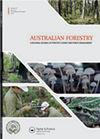驯化为保护受到威胁的太平洋檀香提供了关键
IF 1.2
4区 农林科学
Q3 FORESTRY
引用次数: 8
摘要
亚西圣诞树是一种高价值的半寄生树,原产于斐济、纽埃和汤加。它因其出产石油的心材而被过度开发,现在受到威胁。剩余的林分缺乏遗传多样性,很可能遭受近亲繁殖抑制,尽管该物种总体上仍具有显著的遗传多样性。我们认为,保护该物种的最佳方式是通过积极的驯化计划,该计划将在迁地和环地种植中充分采样和保护遗传基础。yasi树育种的方法可以被描述为一种低投入策略,包括早期使用分子标记来确定种群参数。长期的成功将与剩余遗传资源的保护有着密切的相互依存的联系。建议采用一种基于关键性状反复选择和育种的策略,包括心材体积和年产油量、油质和与抗气旋性和病虫害耐受性相关的环境适应性。已经开始在斐济和汤加的整个自然范围内建立基于该物种收集的基因保护站。文中讨论了鸭嘴草的保护和驯化面临的挑战。其中包括可以进行石油特征化之前所需的高级年限;需要评估基因型与寄主植物的相互作用;以及需要相对复杂的设备和破坏性的收获来进行石油评估。太平洋岛屿专业工作人员的能力发展是实施有效战略的另一个先决条件。研究心材形成和油特征的变异和遗传力,更好地了解S.yasi的育种生物学及其与外来印度檀香(S.album)之间的基因流动,是当务之急。在有计划、精心设计的试验种植中,S.yasi个体需要十多年——可能大约20年——才能有足够的心材发育来进行油特性评估。建立这样的审判是当务之急。除了这项长期活动外,我们建议采取一种简单的临时策略,促进以幼苗为基础的种植种群的高遗传多样性。这可以通过基因保护林分、可以扑杀到幼苗种子园的后代试验以及基于基因多样性的种子林分的组合来实现。该策略将为防止多样性的进一步丧失提供保障,并促进广泛的异交。从近亲繁殖萧条中释放支离破碎的种群有望提高总体活力。本文章由计算机程序翻译,如有差异,请以英文原文为准。
Domestication provides the key to conservation of Santalum yasi – a threatened Pacific sandalwood
ABSTRACT Santalum yasi is a high-value hemiparasitic tree endemic to Fiji, Niue and Tonga. It has been overexploited for its oil-yielding heartwood and is now threatened. Remaining stands lack genetic diversity and are likely to be suffering from inbreeding depression, although the species still has significant genetic diversity overall. We argue that the best way to conserve this species is through an active domestication program that will adequately sample and conserve the genetic base in ex situ and circa situm plantings. The approach to S. yasi tree-breeding can be characterised as a low-input strategy involving the early use of molecular markers for population parameter determination. Long-term success will have strong interdependent links with the conservation of the remaining genetic resources. A strategy based on recurrent selection and breeding for key traits—including heartwood volume and oil yield per year, oil quality and environmental adaptability related to cyclone resistance and the tolerance of pests and diseases—is recommended. The establishment of genetic conservation stands based on collections of the species throughout its natural range in Fiji and Tonga has commenced. Challenges associated with the conservation and domestication of S. yasi are discussed. These include the advanced age required before oil characterisation can be undertaken; the need to assess genotype–host-plant interactions; and the need for comparatively sophisticated equipment and destructive harvesting to carry out oil assessments. Capacity development of professional staff in the Pacific Islands is an additional prerequisite for implementing an effective strategy. Research into the variation and heritability of heartwood formation and oil characteristics, and a better understanding of the breeding biology of S. yasi and geneflow between it and exotic Indian sandalwood (S. album), are high priorities. It will be more than a decade—probably around 20 years—before S. yasi individuals in planned, well-designed trial plantings have sufficient heartwood development to enable oil-trait assessment. Establishment of such trials is an immediate priority. In addition to this long-term activity, we recommend a simple interim strategy that promotes high genetic diversity of seedling-based planting stock. This can be implemented using a combination of gene conservation stands, progeny trials that can be culled to seedling seed orchards, and genetically diverse community-based seed stands. The strategy will both provide a safeguard against the further loss of diversity and promote wide outcrossing. Releasing fragmented populations from inbreeding depression is expected to increase general vigour.
求助全文
通过发布文献求助,成功后即可免费获取论文全文。
去求助
来源期刊

Australian Forestry
FORESTRY-
CiteScore
3.70
自引率
4.80%
发文量
15
审稿时长
>12 weeks
期刊介绍:
Australian Forestry is published by Taylor & Francis for the Institute of Foresters of Australia (IFA) for scientific, technical, and professional communication relating to forestry in the Asia Pacific.
 求助内容:
求助内容: 应助结果提醒方式:
应助结果提醒方式:


